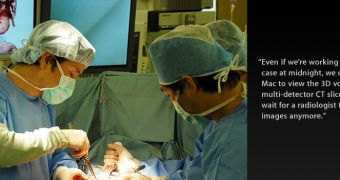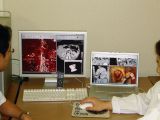Maki Sugimoto, an assistant professor at the 520-bed Teikyo University Chiba Medical Center, near Tokyo, uses Macs to plan and conduct both minimally invasive and aggressive open surgery. The patients are in good hands, thanks to reliable imaging technology leveraged by a Mac Pro workstation, an Apple Cinema Display, as well as a MacBook Pro.
Maki Sugimoto builds what is known as a “surgical roadmap” for patients diagnosed with cancer. Apple was intrigued by the professor’s procedures, and decided to head over to the Center’s radiology department where the patients undergo CT scans. The scans provide Dr. Sugimoto with the DICOM files. He runs OsiriX on a Mac Pro or a MacBook Pro to segment them into volumetric 3D images that he uses to plan and perform surgery.
OsiriX is a Mac-based open-source software system for viewing DICOM-format radiological images. Apple reveals that Sugimoto was browsing the Apple Web site in 2004 when he came across OsiriX. He downloaded it and, as he was experimenting with it, he realized he had found the navigation aid he needed.
“When you’re driving into new territory, you want a map, or better still a navigation system,” says Sugimoto. “We wanted to improve surgical accuracy and efficiency with image-guided navigation. We wanted all the surgeons on the surgical team to see the same visual data, the same images, so we can make informed decisions jointly.”
However, since Sugimoto's specialty (hepato / biliary / pancreatic surgery) involves navigating through particularly complex anatomy, he wanted a better approach to navigation for planning and performing both aggressive and minimally invasive surgeries. For this, he needed remote control of realtime-rendered volumetric images in the operating room, including images projected onto the patient.
The perfect solution proved to be Apple's offerings. Dr. Sugimoto now uses an 8-core Mac Pro or a MacBook Pro to run OsiriX. The DICOM viewer creates volumetric images from patients’ CT and MRI scans. The images are then displayed on a 23-inch Apple Cinema Display in the operating room. He also uses the Mac Pro and a projector to display the images on patients’ bodies when preparing them for laparoscopic surgery.
According to the report, thanks to Apple's solutions and OsiriX combined, the results are “more efficient navigation, better surgical results, and better patient outcomes.”

 14 DAY TRIAL //
14 DAY TRIAL // 
